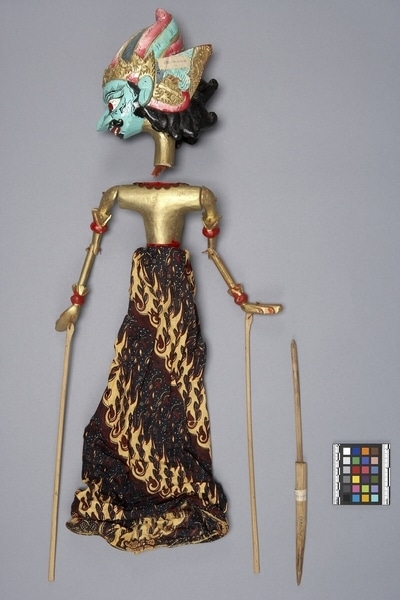Rod Puppet Item Number: Ib412 a-c from the MOA: University of British Columbia


Description
Three-dimensional male humanoid puppet: large head (part b) fits into body with skirt (part a), and a control rod (part c) with a long shaft that passes through the body and fits into the neck of the figure's head. The body has jointed arms, each with a long controlling rod attached. Green face, positioned downwards, with exaggerated features: wedge shaped nose, bulging white eyes with red irises, wide red lips and white teeth. Moustache, small beard, hair, and other facial details in black. Tear-drop shaped decoration on both cheeks. Wound head cloth with diadem in red, green, and gold. Gold badong at rear with green Garuda Mungkur (short tongue) with grey base and red and gold sumping. Five curls of black hair extend from headdress at rear. Gold neck and torso, muscular but not corpulent. Arms have red and gold ornaments at wrists and biceps. Hands held flat and bent back at wrist. Red chest covering and apron with brown wavy trim, sequins, and bead decoration. Apron has red waistband, long yellow fringe at bottom. Long batik skirt, beige with blue and red.
History Of Use
Javanese puppetry as an art form probably developed by the 11th century. Wayang golek puppets of western Java appeared during the 16th century. Originally the plays depicted Javanese mythology, but after the Indian conquest of Java the Hindu epics, Ramayana and Mahabharata, were incorporated into the cycles, which comprise about 200 plays. A dalang (puppet master) performs the plays to celebrate important occasions, usually in three acts, with vocal and instrumental accompaniment. Typically they serve a moral and religious purpose, and more recently, one of political commentary. Bayu is known as a god, being the son of Shiva, and also an elder priest. He appears in all cycles; his son, Bima, has inherited many qualities from him, including powers as god of the wind.
Cultural Context
Theatrical performance.
Iconographic Meaning
Each puppet is characterized by its wanda, a Javanese word which describes the specific mixture of elements of size, form, colour, ornamentation and carving. Configuration of face indicates Bima-type character: features are not refined. Position of face suggests some virtue. Green colour of face indicates maturity; gold skin colour denotes nobility, as does hand position, batik, and arm ornaments, and particularly headdress. Puppet shows many similarities with two character forms of Bayu; it appears to be a combination of features (intermediary).
Item History
- Made in Java, Indonesia
- Owned by Donald Bone before January 4, 1980
- Received from Donald Bone (Seller) and Museum of Anthropology Donations Fund (Funding source) on January 4, 1980
What
- Name
- Rod Puppet
- Identification Number
- Ib412 a-c
- Type of Item
- puppet
- Material
- wood, cotton fibre, fibre and paint
- Manufacturing Technique
- carved, painted, tied, woven and sewn
- Part A
- height 54.5 cm, width 21.0 cm, depth 7.5 cm
- Part B
- height 21.5 cm, width 8.5 cm, depth 16.0 cm
- Part C
- height 33.7 cm, width 1.5 cm, depth 1.3 cm
Who
- Culture
- Sundanese
- Previous Owner
- Donald Bone
- Received from
- Donald Bone (Seller) and Museum of Anthropology Donations Fund (Funding source)
Where
- Holding Institution
- MOA: University of British Columbia
- Made in
- Java, Indonesia
When
- Ownership Date
- before January 4, 1980
- Acquisition Date
- on January 4, 1980
Other
- Condition
- fair
- Accession Number
- 0586/0032 a-c